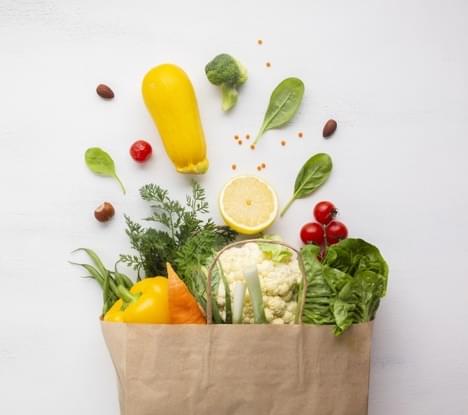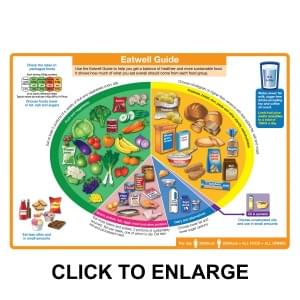What Should We Be Eating?
What should we be eating?
What should we be eating?
(Click on Links in Blue for More Info)
Whether we wish to increase muscle mass, reduce our levels of body fat or just consume a healthy, balanced diet, there is a lot of information available to guide us. Typically, this relates to the macronutrients, i.e., protein, fat and carbohydrate, and how much of each we should consume, which tends to be expressed either relative to our body weight or as percentage of our energy intake. For example, the International Institute of Sports Nutrition suggests that we need to consume 2.3 – 3.1 g/kg/d of protein to maximize the retention of lean body mass when we are reducing our levels of body fat (1). While the World Health Organization (WHO) recommends that less than 30% of our total energy intake should come from fats (2).
As useful as this information is, it doesn’t tell us what actual foods we should be consuming to obtain the requisite levels of the various nutrients. For example, boiled sweets and brown rice are both sources of carbohydrate but have very different effects on our body and implications for our health. So, in this article we are going to provide some guidance on the various types of foods we need to consume to ensure that our diet accommodates our health and performance needs.
Note: While the exact make-up of a balanced and healthy diet will vary depending on your individual characteristics, e.g. age, gender, lifestyle, level and type of physical activity, culture, and the local availability of foods, the basic principles of what constitutes a healthy diet remain the same. The information contained in this article relates only to the nutritional needs of apparently healthy adults. If you are pregnant or breast feeding you should seek the advice of a suitably qualified health care professional regarding your specific nutritional requirements.
We’ll begin by taking at an overview of what a well, balanced nutritious diet looks like. To help us to do this, the Department of Health provides the Eatwell Guide (3).
To learn more about the Eatwell Guide and find lots of other interesting and useful information on nutrition click on the link below.
The Eatwell Guide
Fruit and vegetables: Getting your 5 a day
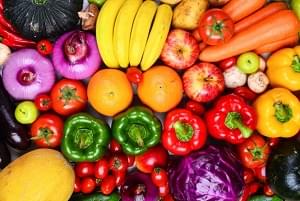
Fruit and vegetables are a good source of vitamins, minerals and fibre. So, we should aim to consume at least 5 portions of a variety of fruit and veg each day. These can be fresh, frozen, tinned, or dried.
This raises the question: What counts as a portion?
Technically speaking, an adult portion of fruit or vegetables is typically 80g.
What should we be eating? – Fruit
In terms of fruit this would be 2 or more small fruits, such as 2 plums, 2 kiwi fruit, 3 apricots, 7 strawberries or 14 cherries. A medium sized piece of fruit such as an apple, banana or pear counts as one. With regard to larger fruits, half a grapefruit, 1 5cm slice of melon or 1 large slice of pineapple also qualify as a portion.
A portion of dried fruit is approximately 30g, which is about 1 heaped tablespoon of raisins, currants or sultanas, 1 tablespoon of mixed fruit, 2 figs, 3 prunes or 1 handful of dried banana chips.
It is important to note that dried fruit can be high in sugar. Therefore, to reduce the risk of tooth decay, try to eat it as part of a meal, rather than as a snack.
What should we be eating? – Vegetables
What counts as a portion of vegetables depends on the type of vegetables being consumed. For example, a portion of green vegetables would be 2 broccoli spears or 4 heaped tablespoons of cooked kale, spinach, spring greens or green beans.
With cooked vegetables, 3 heaped tablespoons of carrots, peas or sweetcorn, or 8 cauliflower florets would count as a portion. In terms of salad, a portion would be 1.5 full-length celery sticks, a 5cm piece of cucumber, 1 medium tomato or 7 cherry tomatoes.
When it comes to pulses and beans, 3 heaped tablespoons of baked beans, haricot beans, kidney beans, cannellini beans, butter beans or chickpeas would count as a portion. It is important to note that no matter how many beans and pulses you eat in a day, they only count as a maximum of 1 portion. This is because we need a variety of fruit and vegetables to make sure we get all of the important nutrients. However, this does not apply to green beans, such as broad beans and runner beans, which can count as more than one portion a day.
What should we be eating? – A note about potatoes
Although potatoes are botanically classified as a vegetable, they don’t actually count towards our 5-aday. This is because nutritionally, they are classified as a starchy food, and when consumed as part of a meal, they typically take the place of other starchy carbohydrate foods, such as bread, pasta or rice. The same also applies to yams, cassava and plantain.
Potatoes may not be part of our 5 a day, but they can play an important role in a healthy, well balanced diet as a starchy food, but be careful how you prepare them: Boiled, baked, mashed or roast potatoes with only a small amount of fat or oil and no added salt are a healthy choice, whereas French fries and other chips cooked in oil or served with salt are not so healthy.
What should we be eating? – Juices and smoothies
Fruit and vegetable juices and smoothies can contribute toward our 5 a day, but can only ever count as a maximum of 1 portion and should be limited to no more than a combined total of 150ml a day, which is a small glass. So, if you consumed 1 glass of fruit juice, I glass of vegetable juice and a smoothie in 1 day, that would still only count as a single portion.
We need to limit our intake of juices and smoothies because juicing fruit and vegetables releases the sugars they contain, which can lead to tooth decay. Therefore, it is recommended that if we are going to have a juice or a smoothie we should consume it at mealtimes, rather than as a between-meal snack, to reduce its potentially harmful effects on our dental health.
What should we be eating? – Starchy carbohydrates
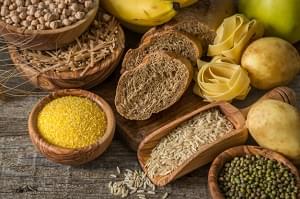
Starchy carbohydrate foods, such as potatoes, bread, rice, pasta, etc, provide us with energy and are the main source of a range of important nutrients in our diet including fibre, calcium, iron and B vitamins. They should make up just over a third of the food we eat. However, this can vary considerably depending on the type of activity an individual participates in. For example, a body builder just prior to competition may cut their carbohydrate intake significantly to help reduce their levels of body fat. On the other hand, an endurance athlete may eat considerably more starchy carbohydrates prior to competition to maximise their energy stores.
One of the most important nutrients we get from wholegrain starchy foods is fibre. This is a substance found in the walls of vegetables, fruits, pulses and cereal grains that cannot be digested but helps other food and waste products to move through the gut to help maintain digestive health. Fibre can also help to make us feel full, which means that we’re less likely to overeat and gain weight.
What should we be eating? – Getting starchy foods into our diet
Here are a few ways we can increase the amount of starchy foods in our diet.
For breakfast, we could try:
- Plain porridge with fruit
- Wholegrain cereals, or mix some in with your favourite healthy breakfast cereals
- Whole oats with fruit and low-fat, lower-sugar yoghurt
For lunch and dinner, we could try:
- A baked potato and eat the skin to increase your fibre intake
- Make oven-baked potato wedges instead of having chips or frying potatoes
- Eating more rice or pasta and less sauce
- Breads such as seeded, wholemeal or granary
- Brown rice, which makes a very tasty rice salad
Ideally, when choosing starchy carbohydrates, we should go for the higher fibre wholegrain varieties, such as whole wheat pasta and brown rice.
Are starchy foods fattening?
Some people believe that starchy foods are inherently fattening and should be avoided. However, they contain only 4 kcal per gram in comparison to fat, which contains 9 and alcohol which contains 7. Obviously, if you eat too many starchy foods then you increase your chance of gaining weight. Also, you need to be aware that the added fats you use when you cook them, will increase their calorie content.
Dairy or dairy alternatives
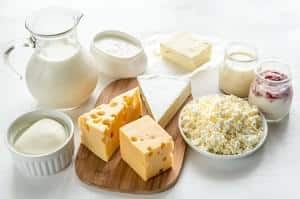
We need to include some dairy or dairy alternatives in our diet. Milk and dairy products, such as cheese, yoghurt and fromage frais are good sources of protein and certain vitamins and calcium, which helps to keep our bones healthy.
To make the healthiest choice we should go for lower fat and lower sugar options, such as 1% fat milk, reduced-fat cheese or plain low-fat yoghurt.
For those people who don’t consume milk and dairy products, there are unsweetened calcium-fortified dairy alternatives available nowadays, such as soya milks, soya yoghurts and soya cheeses and rice, oat, almond, hazelnut, coconut, quinoa and potato milks.
Sources of protein
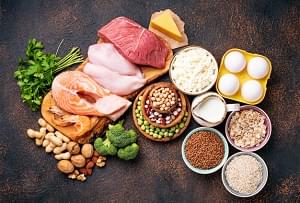
Protein is essential for growth and repair of the tissues of the body and the maintenance of good health. It also provides us with approximately 10 to 15% of our daily energy requirement.
To ensure that we obtain a sufficient intake of protein we should include beans, pulses, fish, eggs, and meat in our diet.
These foods are not only good sources of protein, but also provide us with important vitamins and minerals.
Pulses
Pulses, such as beans, peas and lentils, are healthy alternatives to meat, as they are lower in fat and high in fibre and protein, and so are particularly important sources of protein for those consuming a plant-based diet. They can also be a healthy choice for meat-eaters; adding pulses to soups, casseroles and meat sauces can provide extra texture and flavour. It also means you need to use less meat, which makes the dish lower in fat and cheaper, while still providing sufficient protein.
Fish
Most of us need to eat more fish, including more oily fish. Ideally, we should consume at least 2 portions a week, including 1 of oily fish. This because fish and shellfish are good sources of many vitamins and minerals as well as protein. Oily fish, such as salmon and sardines, is important because it contains high levels of long-chain omega-3 fatty acids, which can help to maintain our cardiovascular health.
Meat
Meat is a good source of protein, vitamins and minerals, but you should eat no more than 70g (cooked weight) of red and processed meat a day, which is actually the average daily consumption in the UK. This limit is suggested because there appears to be a link between red and processed meat and bowel cancer.
When buying meat, we should always try to go for the leanest option. Typically, the more white you can see in a piece of meat, the more fat it contains.
Other things we can do to make our meat selection healthier include:
- Checking the nutrition label to see how much fat it contains and compare it to other products when buying pre-packed meat.
- Eating turkey and chicken without the skin, as these are lower in fat (or remove the skin before cooking).
- Limiting our consumption of processed meat products such as sausages, salami, pâté and beef burgers, and meat products in pastry, e.g., pies and sausage rolls, as they tend to be high in fat and salt.
Eggs
Eggs are an excellent source of protein and also contain various important vitamins and minerals, such as vitamin A and D, folate and iodine. Contrary to popular belief, there is no recommended limit on how many eggs we should eat.
The healthiest way to consume eggs is to cook them without adding salt or fat. For example, frying eggs can increase their fat content by around 50%. Healthier options include boiled or poached, without added salt, and scrambled without butter and using low-fat milk.
Oils and spreads

There is often a tendency to think of all fat as being unhealthy, but this is not true. A small amount of fat is essential for good health, as it provides us with energy and substances known as essential fatty acids that our bodies need but cannot make. It is also a carrier of the fat-soluble vitamins (e.g., A and D) and is necessary for their absorption.
There are a number of different types of fat, the in-depth discussion of which is beyond the scope of this article, but two main ones found in food are referred to as ‘saturated fats’ and ‘unsaturated fats’.
As part of a healthy diet, you should try to cut down on foods and drinks that are high in saturated fats and trans fats and replace some of them with unsaturated fats, such as vegetable, rapeseed, olive and sunflower oils. This is because consuming high levels of saturated fat is associated with an increased risk of cardiovascular disease.
Remember, that whether it’s saturated or unsaturated, fat provides 9kcal per gram. So, we should consume only small amounts of oils and spreads, even of the healthier fats.
Foods high in fat, salt and sugar

Foods high in fat, salt and sugar, such as chocolate, cakes, biscuits, sugary soft drinks, butter, ghee and ice cream, should only be consumed in small amounts and less often.
This because we don’t need them in our diet and overconsumption of such foods is associated with the development of a range of health problems, from tooth decay to obesity, diabetes, cancer and cardiovascular disease.
Fluid intake
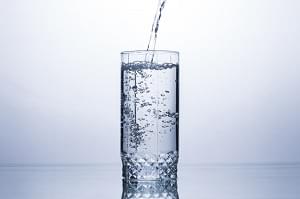
Water makes up nearly two-thirds of our body and performs a wide range of roles from removing waste products in urine to lubricating our joints. It is not only essential for life and health, but also physical and mental performance. Just a 2% reduction in our body mass due to water loss can impair our exercise performance while water losses in excess of 5% have been shown to decrease our capacity for work by approximately 30%. Similarly, dehydration of 2% can increase our perception of fatigue, cause impairment in cognitive functions such as memory and attention, and alter mood.
Consequently, a healthy diet not only consists of the right types and amounts of different foods, but also the right amount and types of fluid. It is currently recommended that we drink 6 to 8 cups or glasses of fluid per day. Water is a healthy and cheap choice for keeping us hydrated and also has the additional benefits of containing no calories and no sugars that can damage our teeth. However, other fluids can also contribute to our fluid intake, such as lower fat milks and lower sugar or sugar-free drinks, including tea and coffee.
It is important to note 6-8 glasses a day is a general guideline and you may need to consume considerably more if, for example, you were exercising in a hot environment.
Energy intake: How many calories should we eat?

The Department of Health recommends that the total energy intake from all food and drink should be approximately 2000kcal per day for a woman and for 2500kcal for a man. However, it is important to understand that this figure can vary considerably depending on the size of an individual, their physical activity levels and goals. For example, a man weighing 100kg would need to consume approximately 2400 kcal just to sustain his body’s essential functions at rest, such as breathing, digestion, etc. If he were to run 10km, he would expend an additional 1000kcal. Consequently, when we allow for all of the energy we expend in a day, such as the energy used to perform the activities of daily living and to digest and metabolise the food we consume, the individual in the earlier example may need to consume 3500kcal or more just to maintain his current physical activity levels and body mass. If he wished to increase his muscle mass, this figure would be in excess of 4000kcal! On the other hand, if he wished to reduce his levels of body fat and body mass, he would need to reduce his energy intake to some degree.
What should we be eating? – Summary
The Department of Health provides the Eatwell Guide to help us to understand the types and proportions of the different food groups we should be consuming to ensure we have a sufficient intake of all of the nutrients essential for good health and performance. However, it is not the definitive, finite account of all of the different foods that can be consumed as part of healthy diet. For example, nuts and seeds aren’t specifically addressed but they can provide many important nutrients. Also, as we have mentioned throughout this piece, your nutritional needs may vary considerably depending on the type and amount of physical you participate in and your personal goals, such as trying to reduce your levels of body fat or significantly increase your muscle mass. Here at Time 4 Nutrition we understand this, and have produced a series of evidence-based articles to provide you with the information you need to make informed choices to best accommodate your specific nutritional needs.
Why not check out our Time 4 Fat Loss Series, which is a 14 part collection of articles, that goes in depth into every aspect of fat loss.
